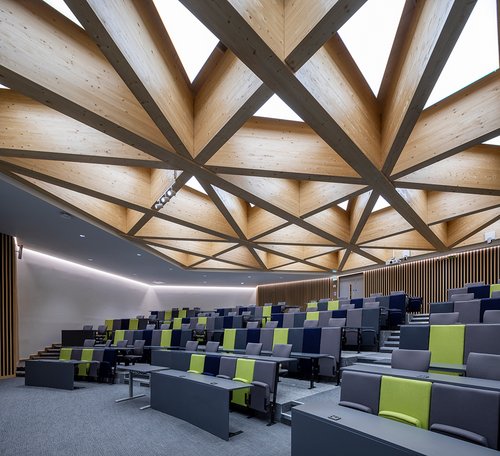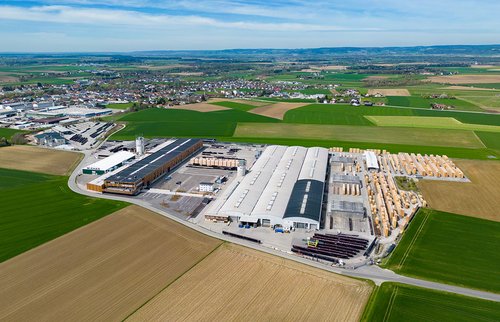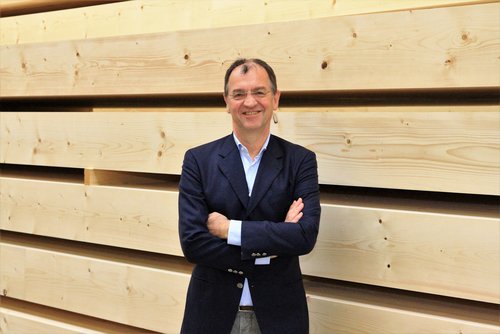Technical University of Nanyang
Singapore focuses on sustainability
Singapore's ambitious "Green Building Master Plan" also provides for increased use of timber as a natural building material. Japanese star architect Toyo Ito therefore decided in favour of a sustainable "mass timber solution" for the new building at Nanyang Technology University.
![[Translate to Englisch:] Nanyang Technological University Singapore [Translate to Englisch:] Nanyang Technological University Singapore](/fileadmin/_processed_/b/d/csm_wiehag-ntu-singapore-18_7cdcc657bd.jpg)
The largest timber building in the whole of Asia - WIEHAG makes it possible
The six-storey "Gaia Academic Building South" is the largest timber building in Asia with a total of 13,000 m³ of GLT and CLT. As is so often the case in large projects where quality and trust are the most important decision criteria, WIEHAG was selected once again. Around 6000 m³ of glued laminated timber for 1,900 support columns and 1,660 beams, including preassembled fasteners, were shipped from Altheim to Singapore in 200 containers.
7000 m³ of CLT for the ceiling structure were supplied by Stora Enso from Ybbs. Delays caused by Covid lockdowns in Singapore and the blocked Suez Canal were partially made up for by the rapid erection. 6 cranes and up to 40 fitters were engaged simultaneously to assemble the timber construction.
![[Translate to Englisch:] Nanyang Technological University Singapore [Translate to Englisch:] Nanyang Technological University Singapore](/fileadmin/_processed_/7/8/csm_wiehag-ntu-singapore-13_58dd0917b3.jpeg)
- Location
- Singapore
- Client
- Nanyang Technological University
- Architecture
- Toyo Ito & RSP
- Mass Timber Contractor
- Steeltech Industries PTE Ltd
- Completion
- 2022
- GLT volume
- 6,000 m³
- CLT
- 7,000 m³







![[Translate to Englisch:] Nanyang Technological University Singapore [Translate to Englisch:] Nanyang Technological University Singapore](/fileadmin/_processed_/9/7/csm_wiehag-ntu-singapore-20_12817a7252.jpg)
![[Translate to Englisch:] Nanyang Technological University Singapore [Translate to Englisch:] Nanyang Technological University Singapore](/fileadmin/_processed_/4/2/csm_wiehag-ntu-singapore-16_e049175da7.jpg)
![[Translate to Englisch:] Nanyang Technological University Singapore [Translate to Englisch:] Nanyang Technological University Singapore](/fileadmin/_processed_/b/d/csm_wiehag-ntu-singapore-18_5730364fda.jpg)
![[Translate to Englisch:] Nanyang Technological University Singapore [Translate to Englisch:] Nanyang Technological University Singapore](/fileadmin/_processed_/b/b/csm_wiehag-ntu-singapore-15_673d03a50a.jpg)
![[Translate to Englisch:] Nanyang Technological University Singapore [Translate to Englisch:] Nanyang Technological University Singapore](/fileadmin/_processed_/a/a/csm_wiehag-ntu-singapore-17_d0a2e92bb0.jpg)
![[Translate to Englisch:] Nanyang Technological University Singapore [Translate to Englisch:] Nanyang Technological University Singapore](/fileadmin/_processed_/2/4/csm_wiehag-ntu-singapore-14_073a949832.jpg)
![[Translate to Englisch:] Nanyang Technological University Singapore [Translate to Englisch:] Nanyang Technological University Singapore](/fileadmin/_processed_/7/8/csm_wiehag-ntu-singapore-13_4e8b79a047.jpeg)
![[Translate to Englisch:] Nanyang Technological University Singapore [Translate to Englisch:] Nanyang Technological University Singapore](/fileadmin/_processed_/5/d/csm_wiehag-ntu-singapore-4_94d7db5fab.jpg)
![[Translate to Englisch:] Nanyang Technological University Singapore [Translate to Englisch:] Nanyang Technological University Singapore](/fileadmin/_processed_/7/d/csm_wiehag-ntu-singapore-14_dbe0da4db0.jpeg)
![[Translate to Englisch:] Nanyang Technological University Singapore [Translate to Englisch:] Nanyang Technological University Singapore](/fileadmin/_processed_/4/9/csm_wiehag-ntu-singapore-5_053b717d1e.jpg)
![[Translate to Englisch:] Nanyang Technological University Singapore [Translate to Englisch:] Nanyang Technological University Singapore](/fileadmin/_processed_/b/1/csm_wiehag-ntu-singapore-6_db13a94d2b.jpg)
![[Translate to Englisch:] Nanyang Technological University Singapore [Translate to Englisch:] Nanyang Technological University Singapore](/fileadmin/_processed_/e/2/csm_wiehag-ntu-singapore-7_568cf84588.jpg)
![[Translate to Englisch:] Nanyang Technological University Singapore [Translate to Englisch:] Nanyang Technological University Singapore](/fileadmin/_processed_/1/2/csm_wiehag-ntu-singapore-8_add385ed1d.jpg)
![[Translate to Englisch:] Nanyang Technological University Singapore [Translate to Englisch:] Nanyang Technological University Singapore](/fileadmin/_processed_/c/e/csm_wiehag-ntu-singapore-9_ea59a889da.jpg)
![[Translate to Englisch:] Nanyang Technological University Singapore [Translate to Englisch:] Nanyang Technological University Singapore](/fileadmin/_processed_/1/3/csm_wiehag-ntu-singapore-10_963e503e6d.jpg)
![[Translate to Englisch:] Nanyang Technological University Singapore [Translate to Englisch:] Nanyang Technological University Singapore](/fileadmin/_processed_/e/a/csm_wiehag-ntu-singapore-11_a1736273be.jpg)
![[Translate to Englisch:] Nanyang Technological University Singapore [Translate to Englisch:] Nanyang Technological University Singapore](/fileadmin/_processed_/d/f/csm_wiehag-ntu-singapore-12_ce618ca454.jpg)
![[Translate to Englisch:] Nanyang Technological University Singapore [Translate to Englisch:] Nanyang Technological University Singapore](/fileadmin/_processed_/1/6/csm_wiehag-ntu-singapore-19_821aaf996d.jpg)
![[Translate to Englisch:] 25 King Bürogebäude Brisbane [Translate to Englisch:] 25 King Bürogebäude Brisbane](/fileadmin/_processed_/f/6/csm_wiehag-25-king-10_a93f93e01a.jpg)
![[Translate to Englisch:] The Import Building [Translate to Englisch:] The Import Building](/fileadmin/_processed_/f/0/csm_wiehag-import-building-01_4b0979bc32.jpg)
![[Translate to Englisch:] IBRB University of Warwick [Translate to Englisch:] IBRB University of Warwick](/fileadmin/_processed_/6/0/csm_wiehag-interdisciplinary-biomedical-research-building-05_7b83d28e89.jpg)
![[Translate to Englisch:] University of Birmingham Teaching Building [Translate to Englisch:] University of Birmingham Teaching Building](/fileadmin/_processed_/6/c/csm_university-of-birmingham-teaching-building-2_3a3faa7c40.jpg)
![[Translate to Englisch:] iLogistics Center [Translate to Englisch:]](/fileadmin/_processed_/c/3/csm_wiehag-ilogistics-center-03_fd51a61f1b.jpg)
![[Translate to Englisch:] Freemen's School Pool Innenansicht [Translate to Englisch:] Freemen's School Pool Innenansicht](/fileadmin/_processed_/1/8/csm_wiehag-freemens-school-pool-05_200f04f0e9.jpg)
![[Translate to Englisch:] Hans Christian Andersen Museum Außenansicht [Translate to Englisch:] Hans Christian Andersen Museum Außenansicht](/fileadmin/_processed_/9/6/csm_wiehag-hca-museum-04_b2431b7352.jpg)